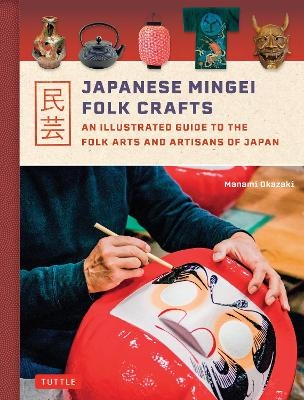
Japanese Mingei Folk Crafts
An Illustrated Guide to the Folk Arts and Artisans of Japan
Seiten
2024
Tuttle Publishing (Verlag)
978-4-8053-1731-0 (ISBN)
Tuttle Publishing (Verlag)
978-4-8053-1731-0 (ISBN)
"In an age when so much of our time is spent staring at screens, it is easy to understand why the warmth, intimacy and idiosyncrasies of hand craftsmanship should seem alluring…the term Mingei describes useful, unobtrusive, beautifully crafted objects." —Alice Rawsthorn, The New York Times
The Mingei Folk Crafts movement, founded by philosopher and art historian Soetsu Yanagi and potters Hamada Shoji and Kawai Kanjiro in the early 20th century, celebrates the utilitarian designs in functional objects hand-crafted by village artisans throughout Japan. This book offers an illustrated guide to Japan's rich folk craft traditions and shows why the Mingei philosophy is even more relevant today than it was a century ago. Folk crafts have become associated with the Slow Life movement and the Wabi Sabi philosophy which values simple and imperfect items above the bright and shiny mass-produced objects of our modern culture.
This book introduces 34 fascinating Japanese folk craft traditions—ranging from popular, widely-known ones to many lesser-known crafts that are equally exquisite but rarely seen. The crafts covered here include:
Aizome Hand-dyed Indigo Textiles which use the leaves of the indigo plant to produce a rich, deep-blue color
Bizen, the unique unglazed pottery with an earthy, rustic appearance—and simple, charming designs
Chochin Lanterns made of handmade washi paper stretched over a bamboo frame, found outside restaurants and temples, including the famous example at the entrance to Tokyo's Sensoji Temple
Edo Furin Wind Chimes made of delicate hand-blown glass, one of the iconic symbols—and sounds—of the hot and humid Japanese summers
Inuharuko Papier Mache Toy Dogs, adorable pups that have acted as good-luck symbols since the Edo period
Maneki Neko Beckoning Cats, one of the most popular folk crafts in Japan, with their right paw raised to bring in money and good luck
Tenugui Cloths, dyed using the chusen method to provide delicate color gradations and used as kitchen cloths, for wrapping or to wear as a scarf, as well as for framing since they are so beautiful!
Author Manami Okazaki describes each craft in loving detail and interviews nine talented folk artists specializing in unique crafts like Koginzashi Needlework, Bingata Dyed Fabrics and Warazaiku Rice Straw Crafts.
This beautifully-illustrated book will be treasured by folk art collectors and enthusiasts worldwide. It features 400 color photographs and a comprehensive guide to buying Japanese folk crafts both inside and outside Japan.
The Mingei Folk Crafts movement, founded by philosopher and art historian Soetsu Yanagi and potters Hamada Shoji and Kawai Kanjiro in the early 20th century, celebrates the utilitarian designs in functional objects hand-crafted by village artisans throughout Japan. This book offers an illustrated guide to Japan's rich folk craft traditions and shows why the Mingei philosophy is even more relevant today than it was a century ago. Folk crafts have become associated with the Slow Life movement and the Wabi Sabi philosophy which values simple and imperfect items above the bright and shiny mass-produced objects of our modern culture.
This book introduces 34 fascinating Japanese folk craft traditions—ranging from popular, widely-known ones to many lesser-known crafts that are equally exquisite but rarely seen. The crafts covered here include:
Aizome Hand-dyed Indigo Textiles which use the leaves of the indigo plant to produce a rich, deep-blue color
Bizen, the unique unglazed pottery with an earthy, rustic appearance—and simple, charming designs
Chochin Lanterns made of handmade washi paper stretched over a bamboo frame, found outside restaurants and temples, including the famous example at the entrance to Tokyo's Sensoji Temple
Edo Furin Wind Chimes made of delicate hand-blown glass, one of the iconic symbols—and sounds—of the hot and humid Japanese summers
Inuharuko Papier Mache Toy Dogs, adorable pups that have acted as good-luck symbols since the Edo period
Maneki Neko Beckoning Cats, one of the most popular folk crafts in Japan, with their right paw raised to bring in money and good luck
Tenugui Cloths, dyed using the chusen method to provide delicate color gradations and used as kitchen cloths, for wrapping or to wear as a scarf, as well as for framing since they are so beautiful!
Author Manami Okazaki describes each craft in loving detail and interviews nine talented folk artists specializing in unique crafts like Koginzashi Needlework, Bingata Dyed Fabrics and Warazaiku Rice Straw Crafts.
This beautifully-illustrated book will be treasured by folk art collectors and enthusiasts worldwide. It features 400 color photographs and a comprehensive guide to buying Japanese folk crafts both inside and outside Japan.
Manami Okazaki has published over a dozen books on Japanese art and culture, including Japanese Kokeshi Dolls. Her articles have been featured in The Wall Street Journal, The South China Morning Post, The Japan Times, Transit and other international publications. She has written extensively on the Tohoku region of northern Japan and curated Kokeshi Japanese doll exhibits in London, Paris, Rome and Los Angeles with a mission to help the people of Tohoku who were so tragically affected by the 2011 earthquake, tsunami and nuclear accident.
| Erscheinungsdatum | 04.07.2024 |
|---|---|
| Zusatzinfo | over 400 color photographs |
| Verlagsort | Boston |
| Sprache | englisch |
| Maße | 191 x 254 mm |
| Gewicht | 879 g |
| Themenwelt | Kunst / Musik / Theater ► Antiquitäten |
| Kunst / Musik / Theater ► Kunstgeschichte / Kunststile | |
| Geisteswissenschaften ► Geschichte ► Regional- / Ländergeschichte | |
| ISBN-10 | 4-8053-1731-0 / 4805317310 |
| ISBN-13 | 978-4-8053-1731-0 / 9784805317310 |
| Zustand | Neuware |
| Haben Sie eine Frage zum Produkt? |
Mehr entdecken
aus dem Bereich
aus dem Bereich
Erinnerungen
Buch | Softcover (2024)
Pantheon (Verlag)
CHF 22,40


